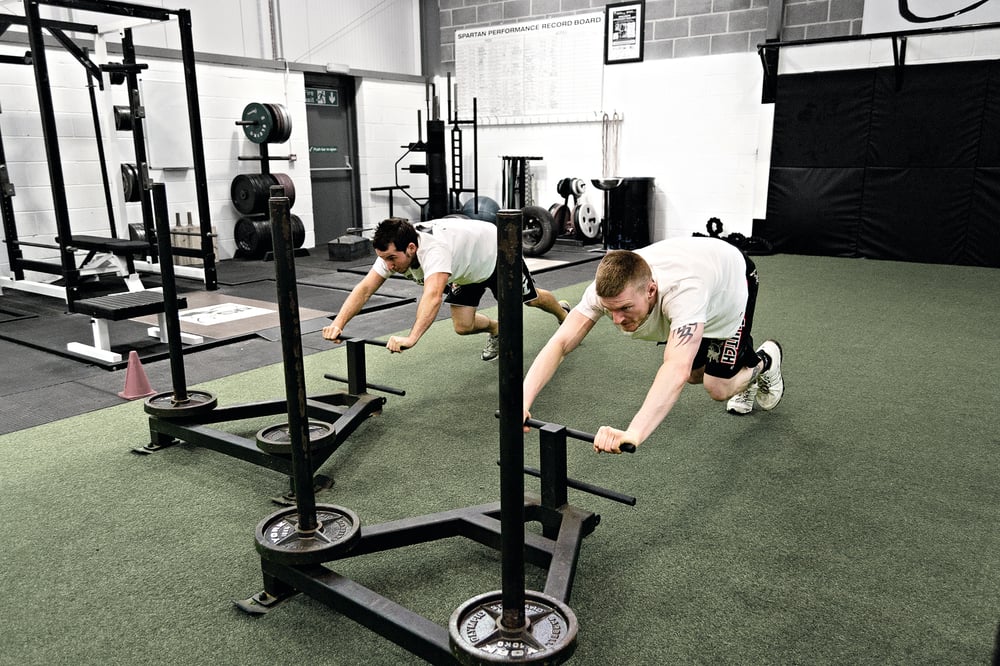
Issue 098
February 2013
Want strength and conditioning gains without the gym-killing next-day ache? Get on the prowl
Paul McVeigh
Sports scientist, TUF 14 cast member and full-time coach – each issue he presents his best training tips
At the gym, we’ve recently been experimenting with a ‘prowler,’ a sled that can be piled with weights then pushed or pulled, and it’s quickly becoming a group favourite. The amount of weight you load up with is determined by the physical quality you are targeting. Want to get stronger? Stack up the plates and get it moving over short distances. If conditioning is your main concern, go lighter and for longer.
WHY I LIKE THE PROWLER
The main reason for my man crush on pushing a heavy, weighted sled around is that the eccentric part of the movement is removed. With traditional strength training, any time the load is lowered it is being controlled by muscles that are elongating under tension. This is the eccentric portion of the lift and it is typically where most of your post-workout soreness and central nervous system fatigue comes from.
That feeling you have a few minutes or hours after you have dead-lifted heavy for a few too many sets is central nervous system fatigue. Combat sports athletes need to stay away from horrific muscle soreness and debilitating central nervous system fatigue. An athlete trying to spar with either makes them less effective, so it’s understandable many people decided strength training was detrimental to sporting performance and was to be avoided.
With prowler training, no eccentric stress means athletes should be fine and able to train without problems the next day. And we have a degree of loading that we don’t get from running.
It should be noted that the lack of the eccentric portion of the movement does limit the prowler’s value as a tool for strength development. Eccentric strength is an important component of overall strength and as the prowler should therefore be seen as an accessory movement, if the goal is the development of strength.
On a side note for those athletes who struggle with the concept of driving through to the cage on their takedowns and shots, I have found a few prowler workouts can really make a difference.

NO PROWLER, NO PROBLEM
As a product, I love the prowler sled. The middle track forces the hips to stay low to generate the appropriate force and with the high and low grabs different body positions can be used. A rope or suspension training system can be attached to the low handles and you have a load that can be pulled, pressed, curled and dragged without any eccentric stress on the muscles.
But if you’re still not convinced of the prowler’s badass-ery, a similar effect can be achieved by performing plate pushes. Place a 20kg plate on the ground (wrap it in a towel if you have concern for your flooring) and place your hands on top with the elbows extended. Drive the plate forward, taking big strides with the legs and staying on the balls of your feet. Try doing 20m sprints up and back for six to eight sets with as much rest as you need in between.
PROWLER WORKOUTS
Prowler sled workouts are synonymous with projectile vomiting. Although amusing for many, this isn’t the benchmark of a great workout. Do not underestimate the prowler; something about the loading and the body position while pushing can make it a bit pukey. But if treated with respect and progressive overload, this shouldn’t be a problem. As with any workout it can be as hard as you want it to be.
FINISHER
Push the prowler for 20m, alternating between the high and low grip, as quickly as possible until you cover 200m total.
HEART RATE RECOVERY
Push the prowler until a near-maximal heart rate is achieved. Rest until heart rate drops by 30–50bpm. Repeat for multiple sets.
PARTNER WORK
Sprint with the prowler for 20m then let a partner sprint for 20m while you recover. Keep alternating for 5–10mins.










